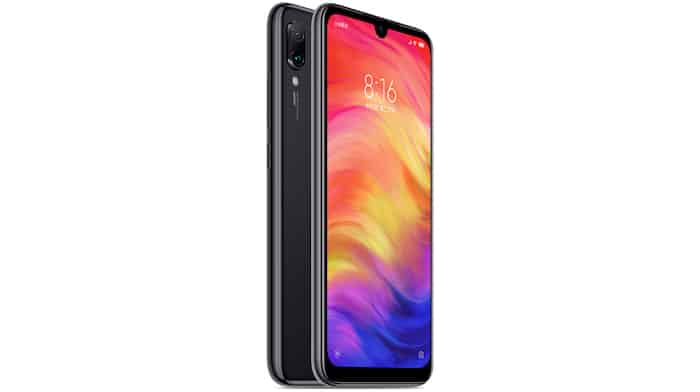1. Looks & Design
The Redmi Note 7 flaunts an all-new Aura design on the back. The design provides a gradient finish on the back side of the phone and can be seen on two color options, Neptune Blue and Nebula Red. The gradient finish gives the device a very appealing look and makes the back look shiny and glossy at varying angles.
Xiaomi has used a 2.5D glass on both, the front and the back of the device to give it a seamless experience across the frame on both sides. With such an appealing design on the back and front of the device, you definitely do not want to get it scratched and messed up. To overcome your concern, Xiaomi has added a Corning Gorilla Glass 5 coating on top of both, the front and the back of the device to prevent dust and debris from causing any scratches or scuffs.
2. Display
The Redmi Note 7 Pro features a 6.3-inch Dot Notch FHD+ display, with a screen resolution of 2340 x 1080 pixels, at a 19.5:9 aspect ratio. With the new display, Xiaomi has managed to provide a bigger screen while keeping similar footprint as the Redmi Note 5 Pro and Redmi Note 6 Pro.
With the Redmi Note 7 Pro, Xiaomi has used the LTPS (Low-Temperature PolySilicon) in-cell screen, which essentially uses less power and generates less heat compared to its counterparts. That allows the display to be stretched all the way to its edges across the bezel, and thus the 2.5D curved design. In addition to the new screen technology, the Redmi Note 7 Pro also comes with a Sunlight Display and Reading Mode. The Sunlight Display makes it easy for the device to be used in outdoor conditions without coming across any brightness issues, for which it automatically adjusts the brightness of the display depending on whether you are indoors or outdoors. On the other hand, the Reading Mode makes it easy to read on your device indoors, by making the display color, brightness, and temperature easier on your eyes.
3. Raw Power
With the Redmi Note 7 Pro, Xiaomi went all out and introduced a 2GHz AIE Octa-Core Snapdragon 675 processor that is 11nm FinFet-based and Kryo 460 series CPU, with an Adreno 612 GPU that comes with 2x Gold Cortex Cores for improved and faster graphics processing capabilities. Additionally, it uses Qualcomm’s Spectra ISP (Image Signal Processor) – to improve image processing and remove bottlenecks that existed earlier while also reducing the need of waking up the CUP or the GPU for any image processing operations, and Qualcomm’s Hexagon 685 DSP (Digital Signal Processor) – to provide improved AI and ML operations that are otherwise not possible on a normal CPU and perform more operations at a slower clock speed to handle thousands of operations coming through. The Snapdragon 675 is a gaming-focused chipset with a lot of raw power to satisfy gamers and power users. Check out our article on the comparison between Snapdragon 675 and Snapdragon 660.
4. Camera
The Camera has been the epicenter of a lot of hype and anticipation that has been built around for weeks before the smartphone’s release. And rightly so. Though we have seen a lot of great cameras over the years, promising a 48MP sensor on the rear at a mid-budget segment seems surreal. But then, it’s true. The Redmi Note 7 Pro sports a whopping 48MP (f/1.79) primary shooter, paired with a 5MP secondary depth sensor on the rear. Xiaomi says that the 48MP camera is a Sony IMX 586 sensor that is essentially a 1.2-inch stacked CMOS sensor and not the Samsung GM1 we saw on the Redmi Note 7 (China version). The company also says that the Redmi Note 7 Pro is one of the first devices ever to sport this sensor and to provide a comparison, it compared the sensor with one of the best smartphone cameras’ in the world, the iPhone Xs Max, which uses a comparatively 25% smaller sensor than the one on Note 7 Pro.
The Sony IMX 586 is being used on Xiaomi’s flagship smartphone, the Mi 9, which is amongst the Top 3 smartphone cameras as per DXOMark. So bringing such a sensor on a mid-range device like Redmi Note 7 Pro, Xiaomi has done really well. To improve night photography, the Redmi Note 7 comes with a steady handheld night photography, based on Xiaomi’s AI algorithm that combines up to four nearby pixels into one to provide more detail in the image while maintaining and improving its overall quality. Additionally, the camera also gets 4k video shooting capabilities at 30fps, 1080p slow motion at 120fps, EIS (Electronic Image Stabilization), and a bunch of AI features like AI scene detection, AI beauty, AI face unlock, and AI portrait selfie. Apart from the 48MP camera on the rear, the Redmi Note 7 Pro also gets a decent 13MP AI front-facing camera on the front for selfies.
5. Battery and Other Hardware
The Redmi Note 7 comes with an impressive 4000mAh battery with Qualcomm Quick Charge 4 support (but packs in 10W charger inside the box) to provide you with a full day’s juice with the ability to quickly recharge the battery again. The device also retains the 3.5mm audio jack and the infamous IR blaster to turn your phone into a universal remote that can be used to operate any electronic appliance at your home. A welcome change for the Redmi customers is the addition of USB Type-C, which allows fast charging and even faster data transfer speeds.










